The Pub Cellar Equipment Market is estimated to be valued at USD 1.6 billion in 2025 and is projected to reach USD 2.3 billion by 2035, registering a compound annual growth rate (CAGR) of 3.8% over the forecast period.
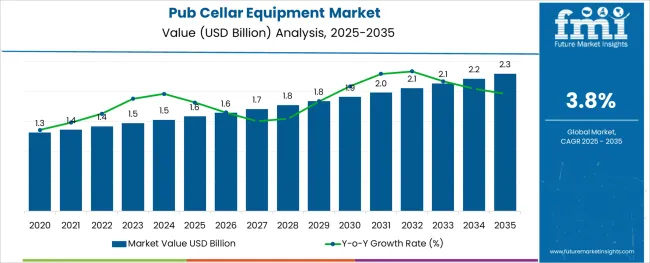
The pub cellar equipment market is undergoing sustained growth as modernization of pubs, increasing focus on operational efficiency, and evolving consumer expectations for quality draft beverages drive investments in upgraded cellar infrastructure. The transition from traditional storage methods to specialized equipment designed for consistent temperature control, hygiene, and space optimization is accelerating market adoption.
Operators are prioritizing equipment that minimizes waste, extends product freshness, and aligns with sustainability practices, reflecting broader trends in the hospitality sector. Future growth is expected to be supported by innovations in compact, energy-efficient solutions, rising premiumization of beer and other beverages, and the continued global expansion of the craft brewing industry.
Strategic collaborations between breweries and pub operators and the growing importance of customer experience as a competitive differentiator are paving the way for long-term market expansion.
The market is segmented by Type, Product Type, Application, and Distribution Channel and region. By Type, the market is divided into Kegs, Taps, and Wine Coolers. In terms of Product Type, the market is classified into Beer, Wine, and Champagne. Based on Application, the market is segmented into Commercial, Residential, and Industrial. By Distribution Channel, the market is divided into Offline and Online. Regionally, the market is classified into North America, Latin America, Western Europe, Eastern Europe, Balkan & Baltic Countries, Russia & Belarus, Central Asia, East Asia, South Asia & Pacific, and the Middle East & Africa.
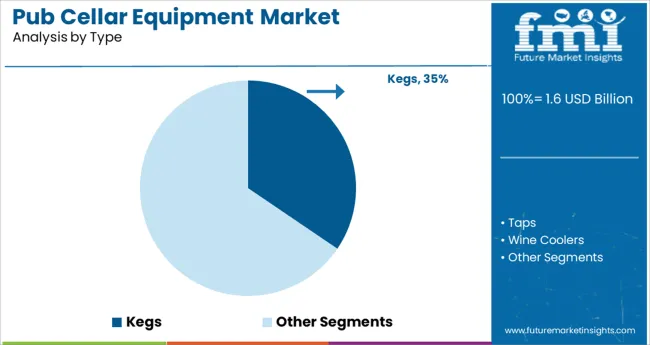
When segmented by type, the kegs segment is projected to hold 34.5% of the total market revenue in 2025, making it the leading type category. This dominance is attributed to the central role of kegs in maintaining beverage quality and supporting efficient dispensing systems in pubs.
The durability and reusability of kegs have enabled their widespread adoption as a cost-effective and environmentally preferable option compared to single-use containers. Technological advancements in keg design, including improved sealing mechanisms and lightweight materials, have enhanced their usability and longevity, further reinforcing their appeal.
Pub operators favor kegs for their ability to preserve carbonation, minimize spoilage, and facilitate quick turnover, which directly impacts profitability and customer satisfaction. The strong alignment of kegs with both operational efficiency and sustainability goals has cemented their position as the preferred choice within the type segment.
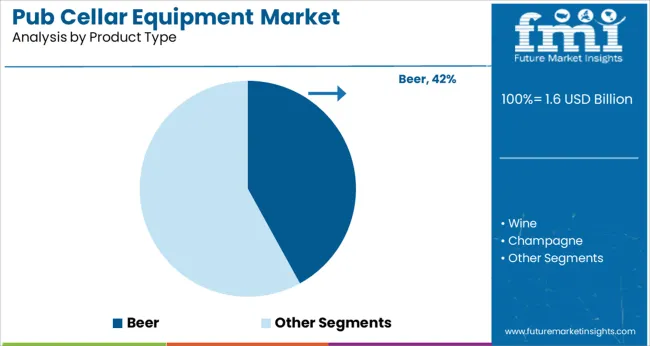
Segmented by product type, beer is anticipated to account for 42.0% of the market revenue in 2025, maintaining its leadership as the primary product category. This leadership has been shaped by the enduring popularity of beer as the cornerstone of pub culture and the increasing consumer demand for diverse and high-quality draft offerings.
Equipment tailored specifically for beer storage and dispensing has been optimized to deliver consistent temperature, pressure, and hygiene, which are critical to preserving flavor and presentation. The rise of craft beer and premium imports has intensified the need for specialized cellar solutions capable of handling a wider range of styles and formats.
The strong emotional and cultural association of beer with the pub experience, combined with its revenue-generating potential for operators, has ensured that beer-focused equipment continues to dominate within the product type segment.
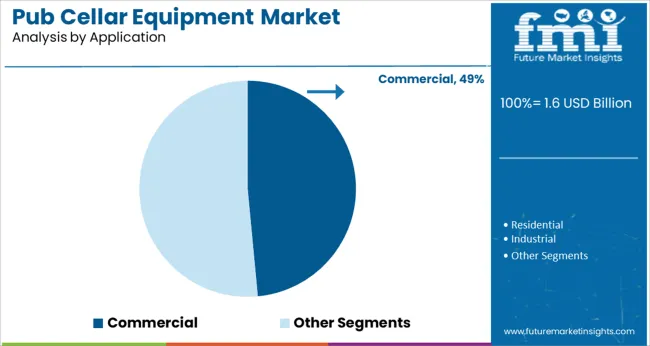
When segmented by application, the commercial segment is expected to capture 48.5% of the market revenue in 2025, establishing itself as the leading application area. This leadership has been driven by the prevalence of pubs, bars, restaurants, and hospitality venues that require reliable and scalable cellar equipment to meet operational demands.
Commercial operators have prioritized investments in robust, easy-to-maintain systems that can withstand high volumes and deliver consistent product quality under varying conditions. The ability of commercial-grade equipment to support diverse beverage portfolios, streamline workflows, and enhance the overall guest experience has reinforced its widespread adoption.
Heightened competition within the hospitality industry and the increasing emphasis on customer satisfaction have further propelled the commercial segment to the forefront, as operators seek to differentiate themselves through superior cellar management and beverage quality.
According to Future Market Insights, the pub cellar equipment market was growing at a CAGR of 4.4% to reach USD 1,413.5 million in 2025 from USD 1,189.8 million in 2020.
The market for pub cellar equipment is forecast to grow significantly in the next decade. The historical outlook for the market was bleak, with little growth forecast. However, the future forecast for the pub cellar equipment market is much more optimistic. The market is expected to grow significantly in the next decade thanks to several factors:
First, the increasing popularity of pubs and bars in developed countries is driving demand for pub cellar equipment. Second, the growing trend of micro-brewing and home brewing is also boosting demand for pub cellar equipment. Third, the rising disposable incomes in developing countries are allowing consumers to spend more on leisure activities such as dining out and drinking at bars, which is also fueling growth in the market for pub cellar equipment. According to research by Future Market Insights, The market is anticipated to expand at a CAGR of 3.8% during the forecast period.
Pub Cellar Equipment Market:
| Differentiating Aspects | Pub Cellar Equipment Market |
|---|---|
| CAGR | 3.8% |
| Market Valuation in 2025 | USD 1.6 billion |
| Projected Market Value in 2035 | USD 2.3 billion |
| Driver | The growing demand for premium beer and low-alcohol beverages is likely to accelerate the pub cellar equipment market share. |
| Opportunity | The key market players are improving automation machinery and contributing key roles in operational efficiencies are growing the market opportunities in the market. |
| Key Trend | The high quality and hygiene equipment, automation process, Internet of Things, sensors, and others are increasing the pub cellar equipment market trends. |
Construction Equipment Market:
| Differentiating Aspects | Construction Equipment Market |
|---|---|
| CAGR | 5% |
| Market Valuation in 2025 | USD 212 Billion |
| Projected Market Value in 2035 | USD 345.33 Billion |
| Driver | The rising demand for construction equipment due to growing infrastructure, demand for heavy equipment, and building activities. |
| Opportunity | Growing residential and commercial infrastructure, the presence of manufacturers, and investment by key companies are increasing the construction equipment market opportunities. |
| Key Trend | Rising the adoption of advanced technologies such as autonomous machinery, operative vehicles, and wireless communication system are increasing the construction equipment market trends. |
Fitness Equipment Market:
| Differentiating Aspects | Fitness Equipment Market |
|---|---|
| CAGR | 5% |
| Market Valuation in 2025 | USD 15.35 Billion |
| Projected Market Value in 2035 | USD 25 Billion |
| Driver | Rising health concerns, focusing on healthy living, and changing lifestyles are increasing the demand for fitness equipment. |
| Opportunity | The manufacturers are developing key role to improve advanced fitness equipment and the growing presence of key manufacturers are surging the fitness equipment market opportunities. |
| Key Trend | The rising exercise classes, swimming pools,s and adoption of exercise equipment are likely to increase the fitness equipment market trends. |
The food and beverage industry dominates the market by capturing a significant share during the forecast period. Many pubs and restaurants are now using pub cellar equipment to store their beverages, and this has resulted in strong growth in the market. Due to the number of customers visiting to have a mug of beer, therefore, the advanced machinery equipment adopted by restaurant owners is limiting their workloads. However, the pub cellar equipment market is forecast to grow significantly in the next few years, supported by strong growth in the food and beverage industry.
Based on application, the market is further categorized into the industrial, residential, and commercial sectors. It is expected that the residential sector is likely to dominate the market size during the forecast period. In addition, people are increasingly interested in having their own private space for entertaining guests. They are also more likely to invest in higher quality equipment for their home if they have disposable income.
In addition, the commercial sector is also expected to see some growth in pub cellar equipment sales. This is because more businesses are starting to realize the benefits of having a private cellar for their business operations. Overall, the market is expected to experience strong growth in the coming years due to the growing popularity of private cellars among both consumers and businesses alike.
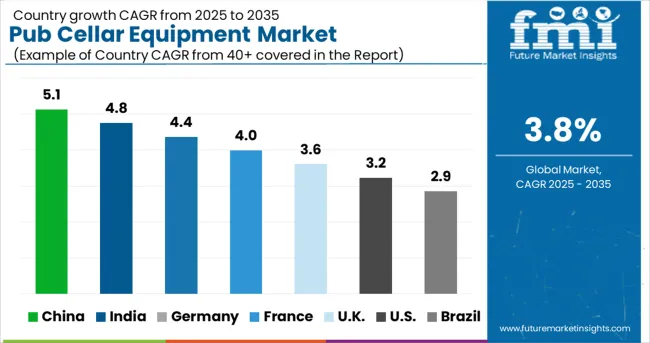
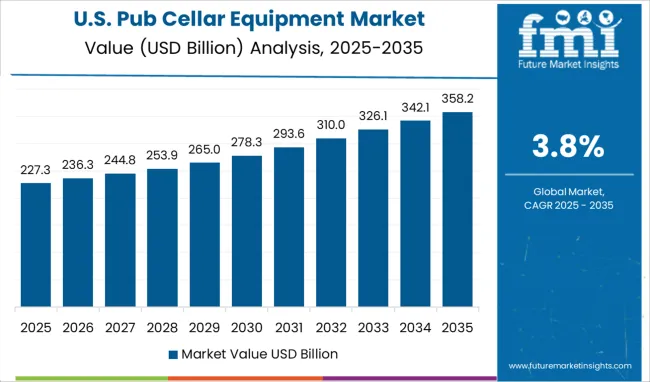
North America is the largest market for pub cellar equipment, accounting for more than a third of the global market share during the forecast period. The USA is the leading nation that contributes the maximum share in the region due to the present number of manufacturers. Some of them are Anheuser-Busch InBev and Molson Coors Brewing Company.
Firstly, the USA has a large number of pubs and bars, which is the main end-use market for pub cellar equipment. Secondly, the region has well-developed distribution channels for pub cellar equipment, making it easy for manufacturers to reach their target customers. Moreover, due to the increasing demand for craft beer and the presence of a large number of microbreweries in the USA. Moreover, Canada is another major contributor to the regional market growth owing to its favorable regulations regarding alcohol consumption and production.
Europe has a long and rich history of brewing beer, which has led to a large and passionate market for pub cellar equipment. The United Kingdom is capturing a higher share in the region due to the high demand for quality beer, the relative ease of doing business there, and the large number of potential customers.
The United Kingdom market is highly competitive, but there is still room for new entrants. To succeed, pub cellar equipment manufacturers need to offer products that are superior in quality and performance to those of their competitors. They also need to have a good understanding of the United Kingdom market and be able to tailor their products and services to meet the specific needs of European brewers.
Asia Pacific is expected to be the fastest-growing market for pub cellar equipment during the forecast period. Korea is one of the dominating nations in the region and is flourishing market size due to the increasing number of pubs and bars, which is fueling the demand for pub cellar equipment. Moreover, the region has a large population base, and the growing habit of consuming low-alcoholic drink in Korea are driving the growth of the market.
Japan is another nation that captures a relevant share of the market due to the rising disposable income and changing lifestyle of people during the forecast period. The rising consumption of beer and the adoption of pub cellar equipment in bars are accelerating the Japan pub cellar equipment market size. In addition, the increasing tourism activities and growing wide infrastructure are also expected to boost the growth of the global pub cellar equipment market over the forecast period.
Start-up Companies are Adding Value through Innovative Advanced Sensor Pub Cellar Equipment
Start-up companies are adding value in the market by performing better tasks in recent years. The start-up companies are developing highly advanced pub cellar equipment for end-use industries to provide fresh beer to customers' tables. These companies are coming up with innovative skills to provide better and last-long brewery equipment to store beer products with advanced technology.
Nowadays, the advanced sensor pub cellar equipment is offering self-service facilities in bars and restaurants, increasing the market trends. However, innovative ideas and deep-down analysis by start-ups are booming the pub cellar equipment industry in the coming years.
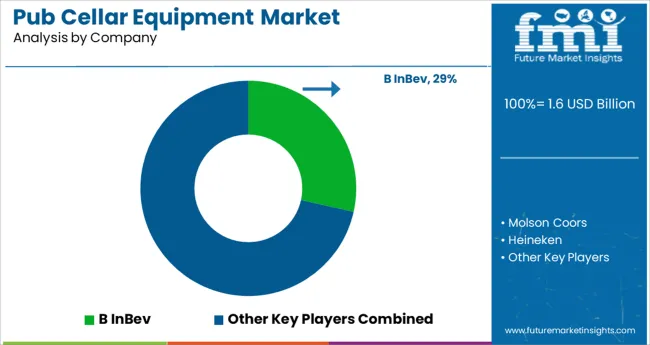
The market for pub cellar equipment is highly competitive, with a large number of players. The key players in the market are AB InBev, Heineken, Molson Coors, Carlsberg, and Diageo. The major players in the market are engaged in intense competition to gain market share. The market for pub cellar equipment is fragmented, with a large number of small and medium-sized manufacturers. The prices of pub cellar equipment vary widely depending on the type and quality of the product. The demand for pub cellar equipment is growing due to the increasing popularity of pubs and bars.
Recent Developments in Pub Cellar Equipment:
The global pub cellar equipment market is estimated to be valued at USD 1.6 billion in 2025.
It is projected to reach USD 2.3 billion by 2035.
The market is expected to grow at a 3.8% CAGR between 2025 and 2035.
The key product types are kegs, taps and wine coolers.
beer segment is expected to dominate with a 42.0% industry share in 2025.






Full Research Suite comprises of:
Market outlook & trends analysis
Interviews & case studies
Strategic recommendations
Vendor profiles & capabilities analysis
5-year forecasts
8 regions and 60+ country-level data splits
Market segment data splits
12 months of continuous data updates
DELIVERED AS:
PDF EXCEL ONLINE
Public Announcement System Market Size and Share Forecast Outlook 2025 to 2035
Public Cloud Application Infrastructure Services Market Size and Share Forecast Outlook 2025 to 2035
Public Safety & Security Market Size and Share Forecast Outlook 2025 to 2035
Public Cloud Application Services Market Analysis - Size, Share, and Forecast Outlook 2025 to 2035
Public Key Infrastructure (PKI) Market Analysis - Growth & Forecast through 2034
Public Safety In-Building Wireless DAS System Market
Public Cloud Storage Market
Book Publishers Market Insights - Growth & Demand Forecast 2025 to 2035
Social Publishing Application Market Size and Share Forecast Outlook 2025 to 2035
AI for Public Security and Safety Market
Digital Publishing Platforms Market Size and Share Forecast Outlook 2025 to 2035
Outdoor Public Safety Market Growth Size, Demand & Forecast 2025 to 2035
IoT for Public Safety Market
Precocious Puberty Treatment Market Overview – Growth, Trends & Demand Forecast 2025 to 2035
Mobile Notary Public Market Size and Share Forecast Outlook 2025 to 2035
AI In Government And Public Services Market Size and Share Forecast Outlook 2025 to 2035
Micellar Casein Market Analysis - Size, Share, and Forecast 2025 to 2035
Micellar Water Market
Wine Cellar Market Size and Share Forecast Outlook 2025 to 2035
Native Micellar Casein Market – Growth, Demand & Industry Innovations

Thank you!
You will receive an email from our Business Development Manager. Please be sure to check your SPAM/JUNK folder too.
Chat With
MaRIA